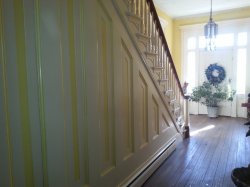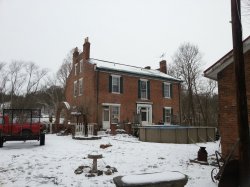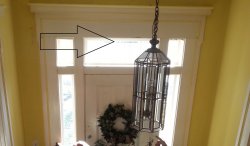I've been researching hearth.com for a long while to try and find a good solution to my heating woes. Here's my plan -- ANY thoughts are much appreciated!
I live in a 3500 sq ft solid brick 1830 Greek Revival home. The home is a square, two rooms on either side of a large central hallway which has exterior doors on each end. I have 12' ceilings, and an open stairwell to the second floor in the hallway. There is a fireplace (four total) in each room, on the exterior wall.
I'm looking to supplement my heating with a pellet stove. From my research, running 45" of 4" chimney pipe would cost at least $500-750 in materials (plus installation). I'm VERY wary of busting out through the back of one of my existing fireboxes for a direct vent (14" of solid brick!), and given the location of each chimney, it would not be an optimal set-up for heating a large area.
HOWEVER, the central hallway would be a very good location for heat distribution. There is an exterior door at each end of the hallway, surrounded by a transom and side-lights set in a wood frame. I understand that codes & manufacturers recommend against install near doors/windows due to back-gassing and CO2 dangers.
My thought: a semi-permanent winter-only installation of the pellet stove. I would "seal" the door (lock, remove doorknob, etc., effectively turning it into a wall. The sidelights are sealed and not designed to open, so no danger of CO2 (do they still count as windows for code purposes? I live in the country, may not matter either way . . . ).
I would remove the transom window and fill in that space with a "wall" of two exterior-grade OSB sheets, insulation, and a thimble in the center. I would set the pellet stove in front of this door, and run the pipe through the thimble and out of the house. If necessary, I could drill a smaller hold in the bottom of the door for an OAK.
Does rendering the door inoperable and utilizing the thimble in this direct-vent scenario take care of any potential problems with this set-up? Am I missing anything crucial?
I live in a 3500 sq ft solid brick 1830 Greek Revival home. The home is a square, two rooms on either side of a large central hallway which has exterior doors on each end. I have 12' ceilings, and an open stairwell to the second floor in the hallway. There is a fireplace (four total) in each room, on the exterior wall.
I'm looking to supplement my heating with a pellet stove. From my research, running 45" of 4" chimney pipe would cost at least $500-750 in materials (plus installation). I'm VERY wary of busting out through the back of one of my existing fireboxes for a direct vent (14" of solid brick!), and given the location of each chimney, it would not be an optimal set-up for heating a large area.
HOWEVER, the central hallway would be a very good location for heat distribution. There is an exterior door at each end of the hallway, surrounded by a transom and side-lights set in a wood frame. I understand that codes & manufacturers recommend against install near doors/windows due to back-gassing and CO2 dangers.
My thought: a semi-permanent winter-only installation of the pellet stove. I would "seal" the door (lock, remove doorknob, etc., effectively turning it into a wall. The sidelights are sealed and not designed to open, so no danger of CO2 (do they still count as windows for code purposes? I live in the country, may not matter either way . . . ).
I would remove the transom window and fill in that space with a "wall" of two exterior-grade OSB sheets, insulation, and a thimble in the center. I would set the pellet stove in front of this door, and run the pipe through the thimble and out of the house. If necessary, I could drill a smaller hold in the bottom of the door for an OAK.
Does rendering the door inoperable and utilizing the thimble in this direct-vent scenario take care of any potential problems with this set-up? Am I missing anything crucial?




